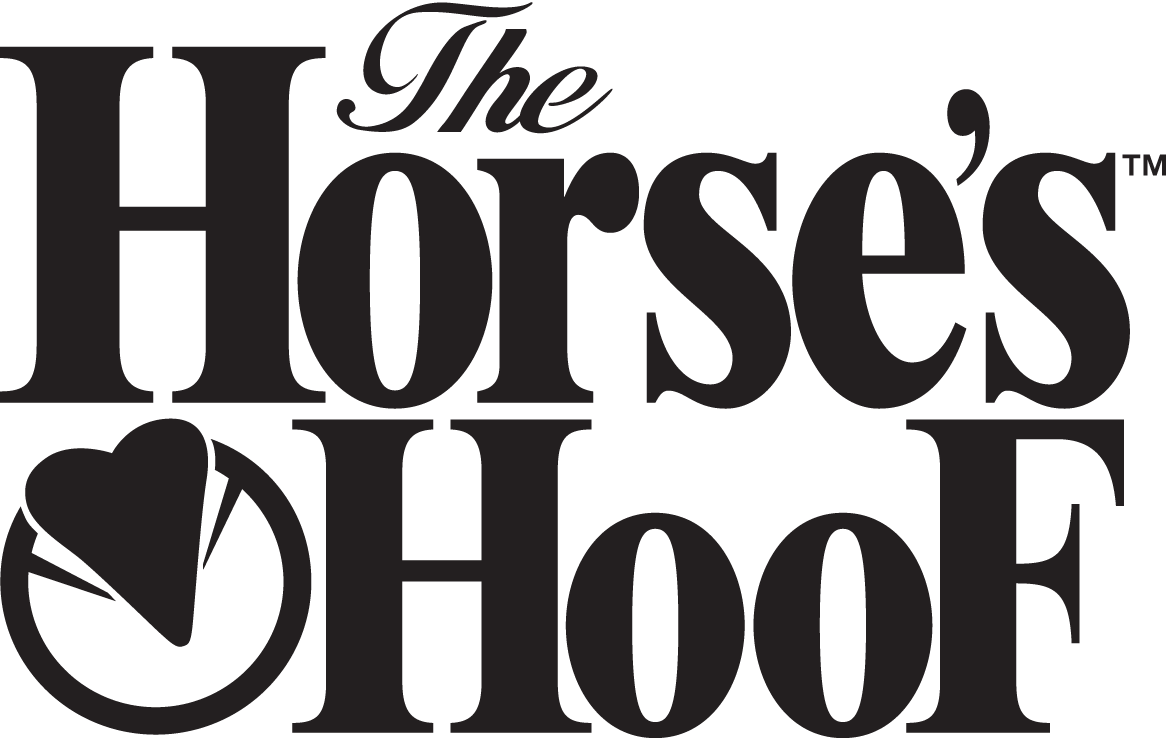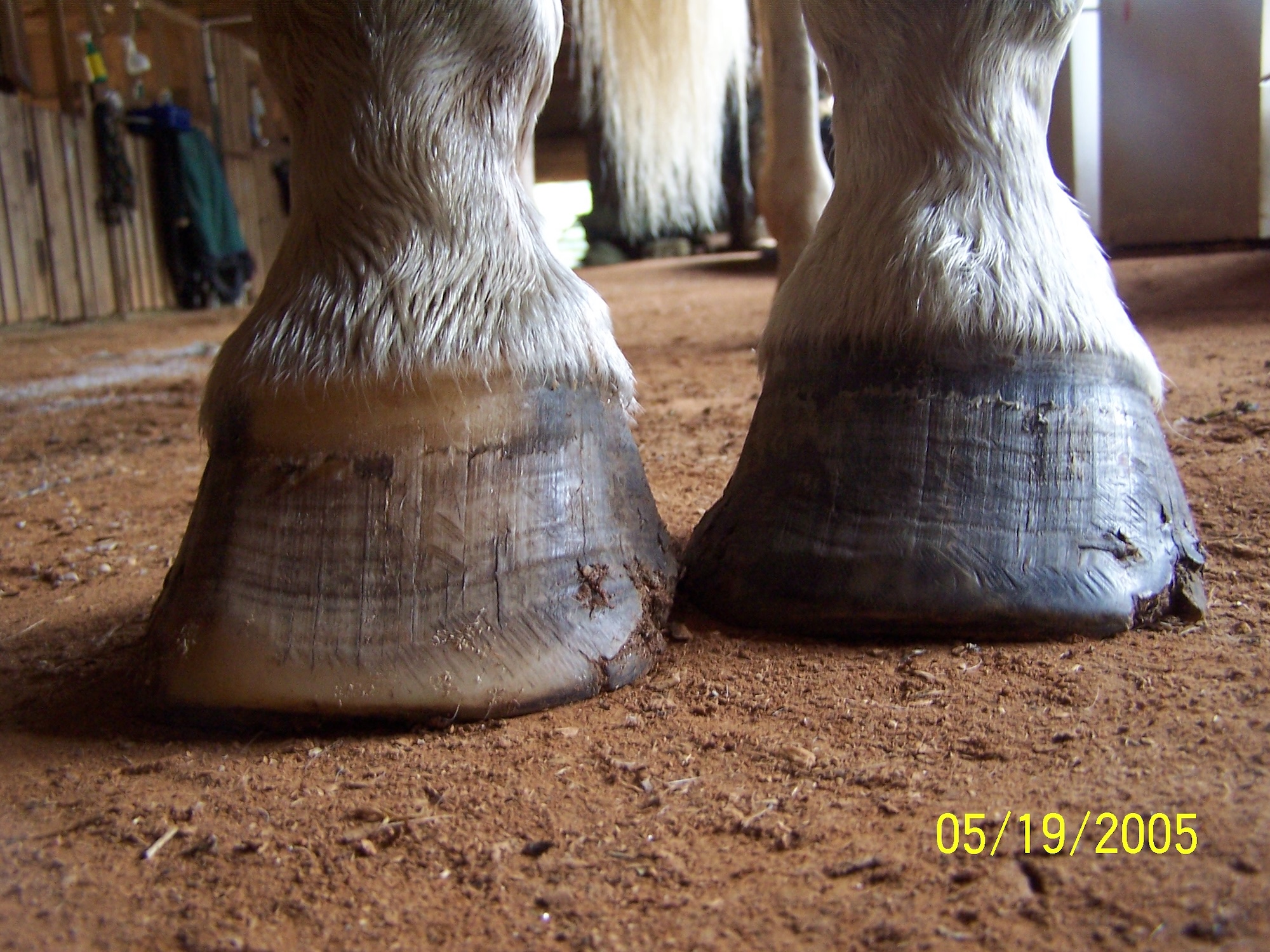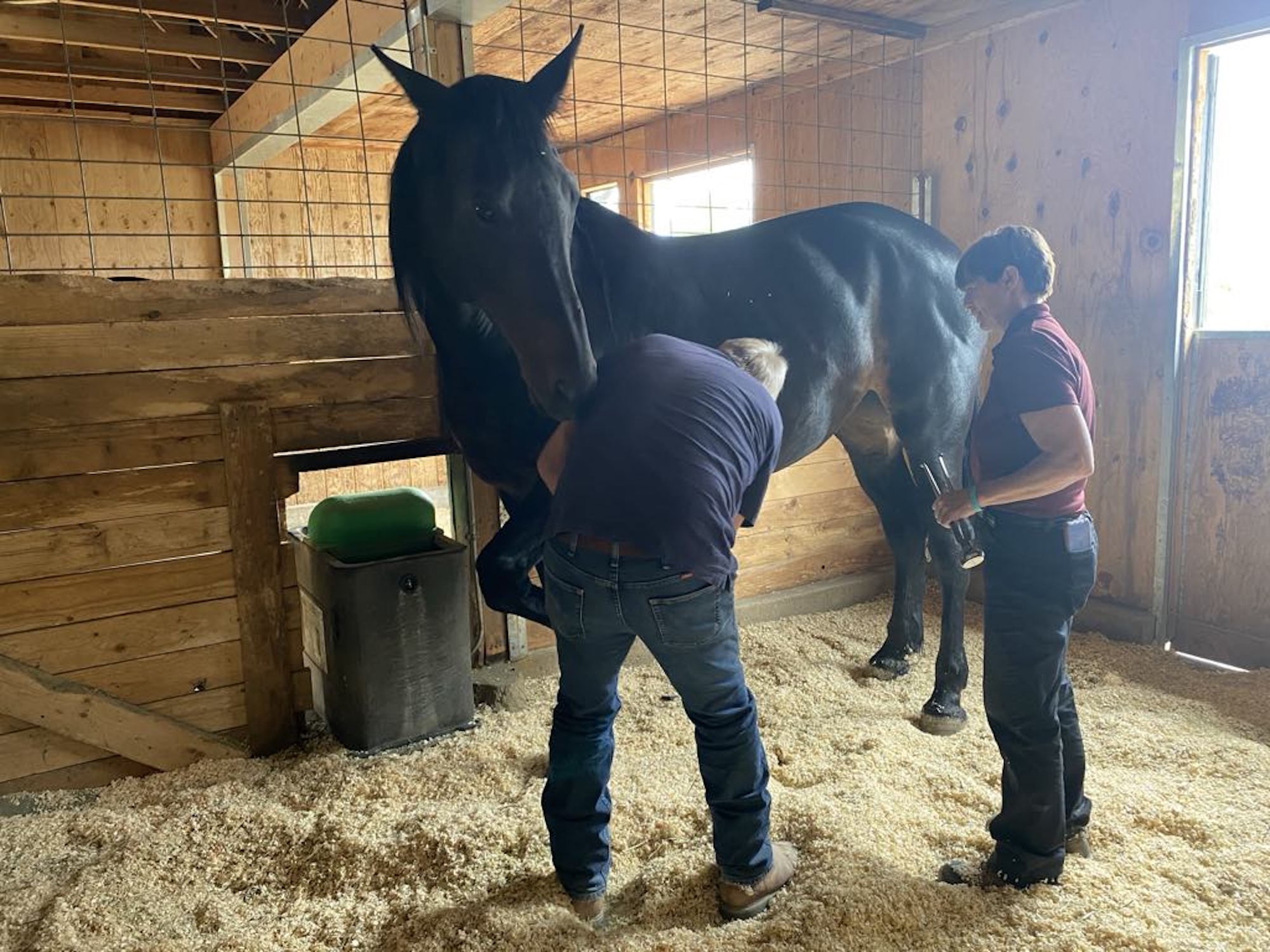When someone asks you who started the barefoot movement, you’ll probably say something like “Dr. Strasser,” or “Jaime Jackson,” or perhaps some other person who stood out in your area of the world at the time you first became involved in barefoot hoof care.
When I went to study with her in the mid-90s, Dr. Hiltrud Strasser had already been teaching her “Basic Hoof Seminars” since 1979, educating horse owners about the harmful effects of shoeing and stall-keeping, which she’d realized during her years of veterinary practice and horse ownership. She had a stack of published books to her name, including a three volume set of detailed hands-on instructions for maintaining healthy and healing diseased hooves. As far as I knew, she was the first person to document the various negative effects of shoeing, and to advocate barefoot as the only way to go.
Then, one day while I was at her home, gathering information from the Basic Hoof Seminars and her already-published books to create the basis of what would become “A Lifetime of Soundness” (LOS), I found a stack of photocopied documents half-buried on a back shelf in her research library. They caught my eye, because they were in english—a language Dr. Strasser did not, at the time, read or speak. When asked, she told me someone had given them to her, thinking they’d be of use to her; but she’d never found out what was in them, because of the language barrier.
She was happy to have me read them, and not only did I tell her what those documents contained—I found it so fascinating that I had to include excerpts of it in LOS. Because in those photocopied pages, I met a man truly belonging into the “beginnings of barefoot” hall of fame: someone already preaching barefoot hoof care over 200 years ago.
He was a veterinarian working at the Royal Veterinary College in London, a scientist and member of several international scientific organizations. He discovered, researched, and, beginning in 1809, published a number of scientific papers about the ill effects of the horseshoe, the anatomy and physiology of the hoof (already chronicling the circulation in the hoof, and how a metal shoe compromised it), and among other things, discovered and named the periople.
Those of you who have read LOS will know that I’m talking about none other than Bracy Clark.
Having been involved in the barefoot movement for about a decade and a half, I find it fascinating to compare what I’ve seen in those relatively short years to what was going on—judging by Bracy’s papers—back in the early 1800s.
Like many of us newly come to the truth about shoeing and barefoot, Bracy was convinced every one would be thrilled by his discoveries, and stunned to find his views slighted and his information suppressed, and himself “condemned unheard, and without examination.”
This opposition, however, did not stop him from publishing his findings. His scientific papers bore such self-explanatory titles as “A Series of Original experiments on the Foot of the Living Horse, exhibiting the Changes Produced by Shoeing, and the Causes of the Apparent Mystery of this Art” and “Podophthora, or A Ruinous Defect in the Principle of the Common Shoe Detected; and Demonstrated by Experiments…”
Like any good scientist, and like many of us today likewise strive to do, he set about providing proof of his findings. He researched horses in other countries, seeing them go well barefoot. Once, as an experiment, he rode about 88 miles in three days on a barefoot horse, to prove to his contemporaries that it is not impossible to ride an unshod horse a few miles a day (the popular opinion of the time). His “A Series of Original Experiments…” featured a number of plaster casts of a five year old mare which had never been shod, but was now to be used and shod. He took casts of the same foot before the first shoeing (Fig 1), and then after one year of continuous shoeing (Fig 2), after two years (Fig 3), and after three years (Fig 4). It must be noted that, before the end of this third year of shoeing, the owner of the horse—having become aware of and alarmed by this demonstrated effect of the shoe on his horse’s hooves—had the shoes taken off and the mare turned out to pasture, effectively interrupting the course of the experiment, and accounting for the slightly less contracted state of the foot at the end of year three.
All artwork courtesy Sabine Kells
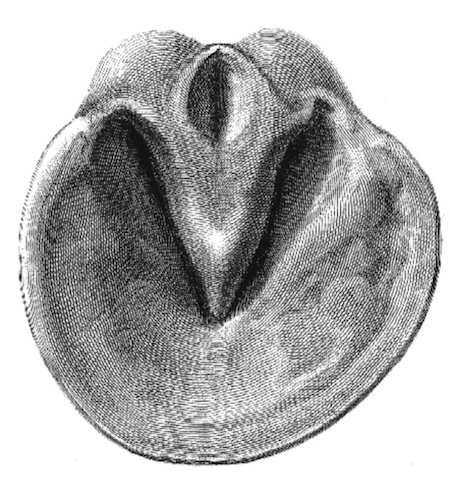
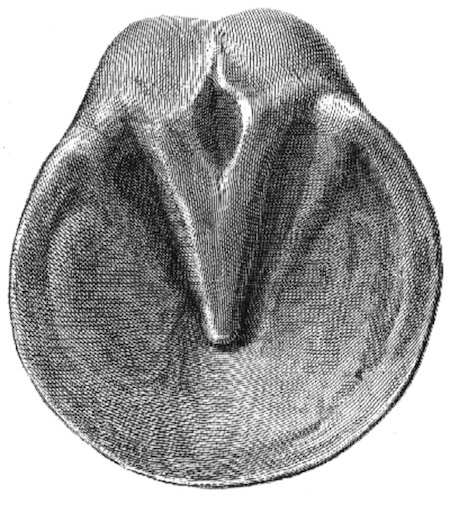
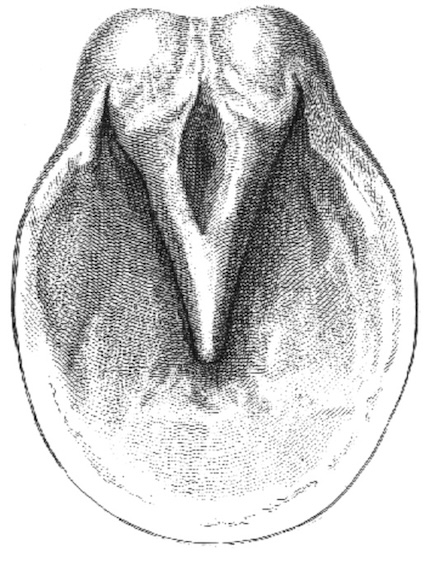
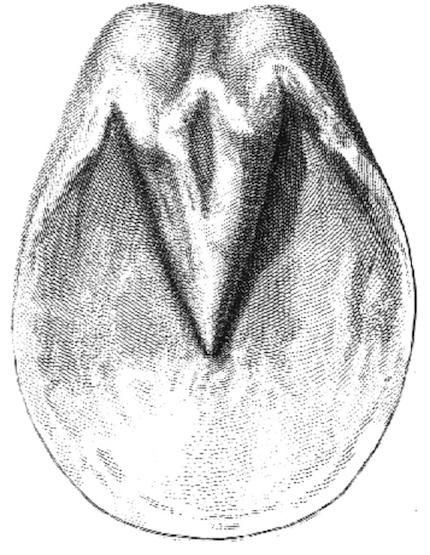
You can feel for that owner, can’t you? After all, how many of us have had shod horses whose feet contracted over the years, never having a clue about this deformation until someone finally pointed it out to us?
In this same document, Bracy noted that “No shoeing-smith or dealer would complain of the foot as it appears in [Fig 2]; though it is a wide departure from the model which nature has established for the foot of the horse… I remember some years back…the first professor of the veterinary college, sending forth to the world with his essay on shoeing, as a model of a perfect foot of the horse, one more diminished than this; nor did he know that nature from the use of the shoe had suffered much change, nor did any of us studying at that time at the college at all suspect it, at least that there was in these cases much alteration of an injurious nature. If horses were brought there with contracted feet, as must have been daily the case, they scarcely obtained notice, from our habits of constantly seeing them in this state, unless they were attended with very great crippling and tenderness indeed…” (pgs 60, 61). Here, too, Bracy describes a phenomenon still common today.
Another experiment published in this paper was on a young mare which “had been very little shod,” which he bought in 1808 (he had intended to buy a 3-4 year old horse which had never been shod, but was unable to find one). Again, plaster casts showed the progression of contraction over three years of continuous shoeing.
He also points out that “before the art of shoeing commenced…” the natural lifespan of the horse was considered to be about 50 years, at least between 32-40, but that in his time “…frequent visits to the slaughter-house…have led us to observe and conclude, that six arrive there before to one after the fourteenth year! For they so early become cripples through the injuries of their feet…” (pg 64)
And: “Horses by the thousands are annually destroyed with circumstances of shameful barbarity, by errors induced upon error, and which custom has rendered too familiar for us to see in its true enormity: and whole centuries have blindly passed away, in which these errors have not been perceived, in an ignorant and thoughtless acquiescence with them…” (pg 90)
He repeatedly points out that “The present system of shoeing, and its consequences, ruin such multitudes of horses, that surely the discovery of its cause, beyond the power of denial, cannot but be of the highest importance in the affairs of mankind; as well also on the account of the sufferings of the animal; for not one in thirty of all that are raised live to see the half of their natural life expended!” (pg 12)
I know those were my sentiments when I first found out that it was shoeing which had nearly caused my mare to be put down. And I’m sure most of you know that same passion, to pass on this important new knowledge you’ve discovered, in order to alleviate the suffering and needless euthanasia of horses around the world.
Just as I’m sure most of you have run into some form of resistance to this new knowledge. And when Bracy’s veterinary peers and colleagues refused to even consider his findings, he was understandably disillusioned, disappointed, and angry: “…they have uttered their absurd dogmas with all the confidence of well-ascertained truths, and afterwards, though plainly confuted, have persisted through pride in maintaining them… And what is worse, when the truth in clearest evidence lay before them, instead of embracing it joyfully, they have tried in every way to stifle her…” (pg 56)
Bracy was an animal rights activist centuries before the phrase was coined. He spoke out sharply, not only against the hostile, aggressive ignorance of his contemporaries, but also against the apparently common abuse of the riding and draft horses of his time. much of it was inflicted on them as a result of horseshoe-induced lameness (severe bits, spurring, whipping, and so on, not to mention needless euthanasia).
He was also highly articulate, and had a razor-sharp pen which should have left those of his contemporaries toward whom his words were aimed bleeding out on the spot. And that pen was aimed not only at his colleagues in scientific and veterinary circles, but also at farriers and horse owners.
In “An Essay on the Knowledge of the Ancients respecting the Art of Shoeing the Horse…,” whose second edition was published in 1831, he writes: “He who first began the practice, whoever he may have been, little suspected he was laying the foundation of more animal suffering than ever it fell to the lot of one man to originate…” (pg 30)
In his “Guide to the Shoeing-Forge,” published approximately 1830, he writes: “The handsome little Horses of Sweden and Norway travel often at the rate of ten, twelve, and even fourteen miles an hour, in their usual work, with a gaiety and vivacity never seen in our Post Horses… The Horses of the West Indies travel delightfully over the rocky ground of those regions, and nearly all the Horses of North and South America, go equally well, and are admired by all strangers for their sound pacing, yet to all these Horses are the blessings of shoeing happily unknown, and they are used entirely without shoes… Let these facts sink deep into the minds of those who ride the cripples of the blacksmiths, maimed, wounded, and disabled, in this country,—let these boasters lay the finger on the lips when they are told these facts, and when they see the roads thronged with the disabled steeds of their making, feetless, ever tripping, stumbling, and tumbling, with iron levers in their mouths (to detract by the infliction of greater pain, or the apprehension of it,) from the feelings of their feet,…
“It will be hardly possible to make posterity believe that such gross follies were ever committed by shoeing-smiths, not rarely, but almost universally; and although the consequences of it have been exposed, explained, and fully proven, nearly twenty years, and though such a thing exists as a Veterinary College,—yet has no mandate ever been issued, or step taken by it to prevent or diminish this flagrant evil…!” (pgs 4, 5)
Whatever may be said of Bracy, he was not a man to sugar-coat his words, or suffer in silence those displaying the folly of ignorance.
And I don’t know about you, but there have been times when I’ve felt in full measure that same frustration and utter disbelief and anger at trying to change a system which seemed to blatantly ignore facts in favor of custom, even if it meant continuing to ruin the lives of horses.
Because, have you noticed: many of the things Bracy lamented are still the case, two hundred years after the information about the damaging effects of horseshoes was first published in scientific circles. shoeing is still an accepted practice, and countless horses still suffer from the resulting damages to their feet, and are still needlessly put down due to these “unknown” effects and related preventable and curable lameness.
I first read Bracy’s papers at a time when I was just learning about hoof anatomy, shoeing and barefoot. I was flabbergasted that politics and economics and personal interests would ever have been able to so completely suppress this scientific information, that not only was it NOT commonly taught in Pony Club and anywhere else riders and horse owners learned and read about how to keep horses, it was unknown even in veterinary circles.
I was very naïve back then. And I have seen some of those same forces at work in the modern world, suppressing this information once again, and for much the same reasons. I don’t think Dr. Strasser, who first began to educate people about the effects of shoeing in the mid 1970s, met with any less resistance, and from the same types of people, as Bracy Clark did.
But not all of it is as bad as it was in Bracy’s day. First of all, we live in the information age. Your average horse owner has access to more information at their fingertips now than probably an entire veterinary college could boast in the 1800s.
And even Bracy, for all he deplored the current state of affairs, understood that the problem lay in a lack of knowledge and understanding among the horse owners. As he writes in “A Series…”: “For let whatever will be said about these effects being known of the shoe, it is clear from the readiness with which people consent to have their horses shod at any age, on the first summons of the breaker-in of the horse, that they view the shoe merely as protecting the foot, and are not aware of its insidious effects; nor do they afterwards exhibit the least jealousy or anxiety about it, but would rather, as we often observe, treat the proposition of its removal as a piece of inhumanity.” (pgs. 55, 56)
Admittedly, most of us have heard that sentiment expressed before by uneducated owners of shod horses; so not much progress, there.
But unlike in Bracy’s day, this time around, in this information age, we can help spread that knowledge to those horse owners who seek it. And, hopefully, also rouse some curiosity about it in those who think they already know it all. Barefoot hoof care is a grassroots movement that has, I believe, already gained far more momentum than anything Bracy could generate in the scientific circles of his time. Here in North America, in just over 10 years, the question in a lot of horse owners’ minds has gone from “shoe or barefoot?” to “which barefoot school?”
And how fantastic is that, for the horses?
So while it may look like, in some areas, things really haven’t progressed very far from Bracy’s day, in a lot of other ways, we are worlds beyond it.
And let’s not forget: while this may be the second time around trying to get this information outright here, right now, this really is just the beginning. Give it another twenty or hundred years, and see how much better a place we’ll have made the world for our horses.
About the author: Sabine Kells lives on beautiful Vancouver Island in British Columbia. She is a Strasser Seminar and Certification Course Instructor.
by Sabine Kells, published in The Horse’s Hoof Magazine, Issue 39, Summer 2010
For more historical barefoot info, please read: “A Timeline of the Barefoot Movement” and “50th Issue Retrospective”.
See the full content listing of all issues of The Horse’s Hoof Magazine! We also provide instructions on how to read the issues for free on Hoof Help Online.
For a detailed listing of all articles on The Horse’s Hoof website, please visit our Article Directory.
